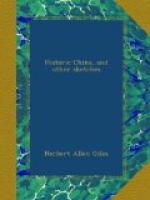MEDICAL SCIENCE, NO. II
Luxuriating in the “mental oasis” of Chinese literature in general, and the “New Collection of Tried Prescriptions” in particular, we have been tempted to carry our researches still further in that last-mentioned valuable work. It would have been sufficient to establish the reputation of any European treatise on medical science had it contained one such simple and efficacious method for extracting teeth as we gave in our chapter on Dentistry; but Chinese readers are not so easily satisfied, and it takes something more than mere remedies for coughs, colds, lumbago, or the gout, to ensure a man a foremost place among the Galens of China. Even a chapter on “Extraordinary Diseases,” marvellous indeed in the eyes of the sceptical barbarian, is not enough for the hungry native mind; and nothing less than a whole section of the most miraculous remedies and antidotes, for and against all kinds of unheard-of diseases and poisons, would suffice to stamp the author as a man of genius, and his work as the offspring of successful toil in the fields of therapeutic science. Thus it comes about that the author of the “New Collection of Tried Prescriptions” gathers together at the close of his last volume such items of experience in his professional career as he has not been able to introduce into the body of his book, and from this chapter we purpose to glean a few of the most striking passages.
To begin with: Mr Darwin will be delighted to hear, if this should ever meet his eye, that the growth of tails among mankind in China is not limited to the appendage of hair which reposes gracefully on the back, and saturates with grease the outer garment of every high or low born Celestial. Elongation of the spine is, at any rate, common enough for Dr Wang to treat it as a disease and specify the remedy, which consists in tying a piece of medicated thread tightly round it, and tightening the thread from time to time until the tail drops off. In order, however, to guard against its growing again, a course of medicine has to be taken, whereby any little irregularities of the yin or female principle[*] may be corrected, and the unpleasant tendency at once and for ever checked.
[*] The symbol of the yin
and the yang, or male and female
principles, has been used
in the beading of the cover to this
volume. The dark half
is the yin, the other the yang.
We then come to elaborate directions for the extirpation of all kinds of parasites, white ants, mosquitoes, &c.; but judging from the plentiful supply of such pests in every part of China, we can only conclude that the natives are apathetic as regards these trifles, and do not suffer the same inconvenience therefrom as the more delicately-nurtured barbarian. The next heading would somewhat astonish us, accustomed as we are to the vagaries of Chinese book-makers, were it not that the section upon which we are engaged is supposed to contain “miscellaneous” prescriptions, which may include anything, though it is a somewhat abrupt transition for a grave medical work to pass from the destruction of insects to a remedy against fires!




